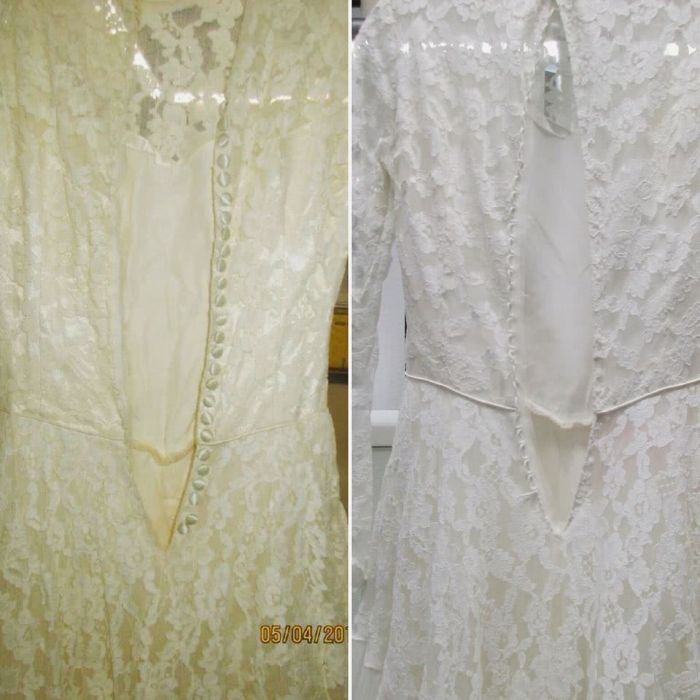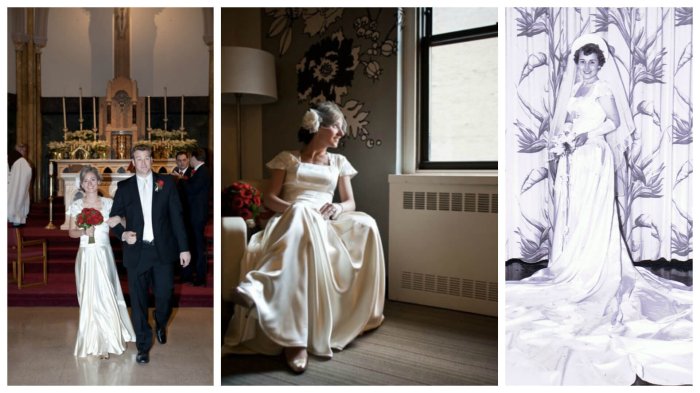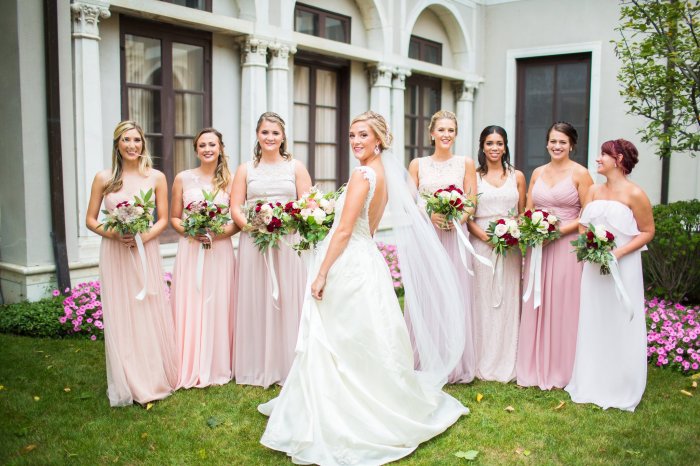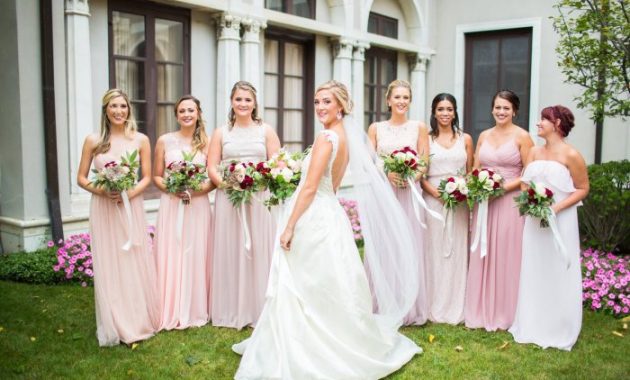The History and Value of Antique Wedding Dresses
Antique wedding dress restoration – Antique wedding dresses offer a captivating glimpse into the past, reflecting evolving fashion trends and societal norms. Their value extends beyond their aesthetic appeal, encompassing historical significance and the craftsmanship involved in their creation. This section explores the factors contributing to the value of these unique garments.
Evolution of Wedding Dress Styles
Wedding dress styles have undergone a dramatic transformation throughout history. From the simple, practical gowns of the Victorian era, often made of heavy fabrics like wool or silk, to the elaborate, ornate designs of the Edwardian period featuring intricate lace and embellishments, each era reflects distinct aesthetic preferences. The 1920s saw a shift towards simpler, more streamlined silhouettes influenced by the flapper style, while the 1950s embraced full skirts and cinched waists, epitomized by the iconic designs of Christian Dior.
The latter half of the 20th century saw a greater diversity of styles, with the 1960s and 70s featuring A-line silhouettes and more casual fabrics, and the 1980s and 90s showcasing a resurgence of elaborate detailing and structured shapes.
Factors Influencing Value
Several factors contribute to the value of an antique wedding dress. The fabric used, such as high-quality silk or hand-embroidered lace, significantly impacts its worth. The maker’s reputation – a renowned designer or a skilled artisan – also adds value. The condition of the dress is crucial; a well-preserved gown commands a higher price than one with extensive damage.
Finally, historical significance, such as a dress worn by a notable figure or representing a specific historical period, greatly enhances its value.
Examples of Historically Significant Dresses
Grace Kelly’s iconic wedding dress, a Helen Rose design, remains a symbol of classic elegance. Its high-necked, long-sleeved design and intricate lace detailing continue to inspire modern bridal gowns. Similarly, Queen Victoria’s wedding dress, made of Honiton lace, set a precedent for white wedding dresses becoming the norm. These dresses, preserved and documented, offer invaluable insights into fashion history and cultural trends.
Material and Construction Comparison
| Decade | Common Fabrics | Construction Techniques | Notable Details |
|---|---|---|---|
| 1880s | Silk, wool, satin | Hand-stitching, corsetry | Long trains, high necklines |
| 1920s | Silk crepe, chiffon, lace | Dropped waistlines, bias cuts | Beaded embellishments, shorter hemlines |
| 1950s | Silk taffeta, satin, lace | Full skirts, fitted bodices | Crinoline underskirts, cinched waists |
| 1970s | Polyester, chiffon, lace | A-line silhouettes, empire waists | Simple designs, often with floral accents |
Assessing the Condition of an Antique Wedding Dress
A thorough assessment is paramount before initiating any restoration work. This crucial step helps determine the extent of damage and guides the restoration strategy, ensuring the preservation of the garment’s historical integrity.
Common Types of Damage
Antique wedding dresses are susceptible to various forms of deterioration. Tears and holes are common, particularly in delicate fabrics like lace. Stains from age, spills, or improper storage are frequent issues. Discoloration, caused by light exposure or chemical reactions, is another common problem. Finally, weak seams, resulting from age and wear, often require attention.
Importance of Pre-Restoration Assessment
A comprehensive pre-restoration assessment is essential to identify all areas needing repair and to plan a suitable treatment strategy. This assessment not only helps prevent further damage but also informs decisions about the most appropriate conservation techniques. A detailed assessment ensures that the restoration process respects the historical and artistic value of the garment.
Inspection Checklist
A systematic inspection checklist ensures a thorough examination. The checklist should include evaluating the overall condition, noting any tears, stains, or discoloration, checking seam integrity, assessing the condition of embellishments like lace, embroidery, and beading, and examining the fabric for signs of fragility or damage. Detailed documentation, including photographs, should accompany the checklist.
Visual Guide to Deterioration
A visual guide illustrating common signs of deterioration would be beneficial. One section could display various types of tears, showing their size, location, and severity. Another section could showcase different types of stains, highlighting their color, size, and likely source. A third section could demonstrate varying degrees of discoloration, from slight yellowing to severe browning. Finally, a section showing examples of weak seams, broken threads, and damaged embellishments would complete the guide.
Each section would include close-up images with clear descriptions of the observed damage.
Cleaning and Preservation Techniques

Source: weddinggownpreservationkit.com
Restoring antique wedding dresses requires specialized skills and a delicate touch, bringing these treasured garments back to their former glory. The cost of such restoration can vary greatly, depending on the extent of the damage. It’s interesting to compare this to the price of a brand new, high-end gown like those by Anne Barge; you can check the average anne barge wedding dress price to get a sense of the investment in a contemporary piece.
Ultimately, preserving a family heirloom through restoration offers a unique connection to the past, often surpassing the value of a new purchase.
Cleaning an antique wedding dress requires a delicate approach, utilizing methods that minimize further damage while effectively removing dirt and grime. The choice of cleaning method depends heavily on the fabric’s composition and the type of soiling.
Cleaning Methods for Delicate Fabrics
Dry cleaning is often the preferred method for delicate antique fabrics as it minimizes the risk of shrinkage or damage. However, hand washing, using mild detergents and cool water, might be suitable for certain fabrics. Spot cleaning, addressing individual stains with specialized cleaning agents, is a targeted approach. The choice of method should be based on the fabric’s composition and the extent of soiling.
Specialized Cleaning Agents and Tools
Specialized cleaning agents designed for antique textiles are crucial to avoid damaging the fabric. These agents are formulated to be gentle yet effective in removing dirt and stains without causing discoloration or weakening the fibers. Appropriate tools, such as soft brushes and sponges, are also essential to avoid abrasive cleaning that could damage the delicate fabric. Professional conservators typically have access to specialized tools and equipment.
Safe Handling and Storage

Source: squarespace-cdn.com
Safe handling and storage are essential throughout the cleaning process. The dress should be handled with clean, cotton gloves to prevent the transfer of oils and dirt. It should be supported on a clean, padded surface during cleaning and stored in an acid-free, archival-quality box or garment bag in a cool, dry, and dark environment. Proper storage prevents further damage and deterioration.
Professional vs. DIY Cleaning
Professional cleaning offers the advantage of expertise and access to specialized equipment and materials. DIY cleaning can be cost-effective but carries a greater risk of damaging the garment if not done correctly. The decision depends on the extent of the damage, the cleaner’s experience, and the value of the dress. For valuable or highly delicate garments, professional cleaning is strongly recommended.
Repair and Restoration Methods
Repairing damaged antique wedding dresses requires specialized skills and techniques to ensure the longevity and aesthetic integrity of the garment. The methods used depend on the type and extent of the damage.
Common Repair Techniques
Tears and holes can be repaired using techniques like invisible mending, patching, or darning, depending on the size and location of the damage. Broken seams are carefully restitched using appropriate thread. These repairs aim to be as inconspicuous as possible while effectively restoring the garment’s structural integrity.
Repairing Damaged Embellishments
Damaged lace, embroidery, and beading require specialized repair techniques. Missing or damaged lace can be carefully replaced with matching lace, while embroidery can be repaired using similar thread and stitching techniques. Loose or missing beads can be carefully reattached, or damaged beads can be replaced with similar ones. These repairs require a high level of skill and attention to detail.
Stabilizing Fragile Fabrics
Fragile fabrics can be stabilized using various methods, including the application of support fabrics or specialized textile consolidants. These methods strengthen the fabric, preventing further deterioration and making it more durable. The choice of method depends on the fabric’s composition and the extent of its fragility.
Necessary Tools and Materials, Antique wedding dress restoration

Source: squarespace-cdn.com
- For Seam Repair: Needles (various sizes), thread (matching colors), seam ripper, thimble
- For Fabric Repair: Patching materials (matching fabric or sheer netting), mending tissue, adhesive (for delicate fabrics)
- For Embellishment Repair: Beads (matching), embroidery floss (matching), fine tweezers, embroidery needles
- For Fabric Stabilization: Textile consolidant, support fabrics (such as silk organza or muslin), acid-free tissue paper
Ethical Considerations in Antique Wedding Dress Restoration
Ethical restoration prioritizes preserving the historical integrity of the garment while addressing its damage. It requires careful consideration of the garment’s history, its aesthetic value, and the impact of any intervention.
Preserving Historical Integrity
Ethical restoration aims to maintain the garment’s historical authenticity. Interventions should be minimal and reversible whenever possible. Any repairs should be clearly documented, allowing future conservators to understand the restoration history and make informed decisions about further treatment. The goal is to preserve the garment for future generations.
Ethical Implications of Alterations
Significant alterations to an antique wedding dress can compromise its historical integrity. While some minor alterations might be necessary for preservation, major changes that alter the original design should be avoided unless absolutely necessary and meticulously documented. The ethical approach prioritizes preserving the original design and craftsmanship whenever possible.
Documenting the Restoration Process
Detailed documentation is crucial for ethical restoration. This includes photographic records of the dress before, during, and after the restoration, detailed notes on the materials and techniques used, and a comprehensive record of any repairs or interventions. This documentation provides valuable information for future conservators and researchers.
Ethically Sourcing Antique Dresses
Ethically sourcing antique wedding dresses involves ensuring the dresses are acquired legally and responsibly. This includes verifying the provenance of the garment, ensuring it has not been stolen or illegally obtained, and supporting reputable antique dealers or auction houses that adhere to ethical sourcing practices. Transparency and accountability are key aspects of ethical sourcing.
Questions Often Asked: Antique Wedding Dress Restoration
How much does antique wedding dress restoration cost?
The cost varies greatly depending on the extent of damage, the type of fabric, and the complexity of the restoration. It’s best to obtain quotes from several reputable professionals.
Can I restore my antique wedding dress myself?
Minor cleaning and repairs might be possible with careful research and practice, but extensive restoration is best left to experienced professionals to avoid further damage.
How can I find a reputable antique wedding dress restorer?
Seek recommendations from museums, historical societies, or antique dealers. Check online reviews and ensure the restorer has experience with delicate fabrics and antique garments.
How long does the restoration process typically take?
The timeframe depends on the extent of the work required, but it can range from several weeks to several months.

